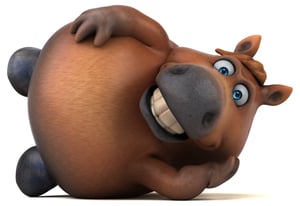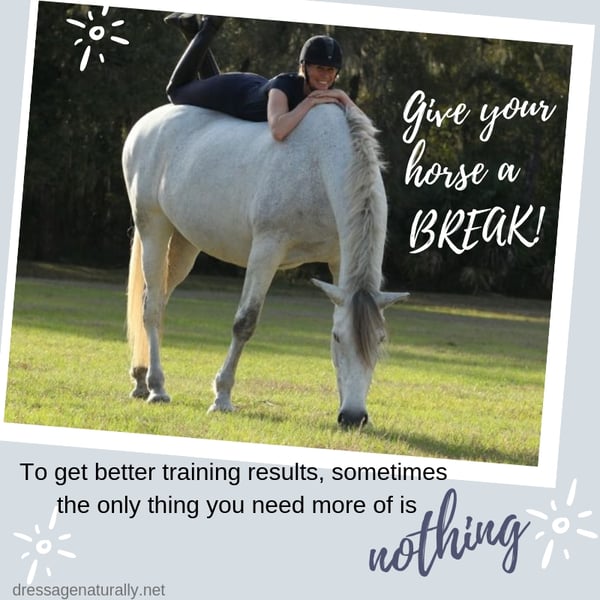It's important to give your horse breaks. A break can mean a day off, or weeks off. In this article, I will talk about breaks during his training sessions. A break can be used as a reward, as a way to emotionally decompress, as physical rest, or a chance to mentally process.
"Everything comes from and returns to Relaxation."
The most important quality of any break is that the horse is able to relax. Everything needs to come from and return to relaxation. If you are starting out with a tense horse, finding relaxation needs to be the top priority and the goal of the session. Once you are able to create relaxation, your training sessions will go better and you will be able to use relaxed breaks as a strategic tool in your sessions.
How to give your horse a break:
In natural horsemanship, people tend to give their horse a break by standing still and dwelling. In dressage, people tend to give their horse a break by walking. Which is the best way?
Well, as with most training questions, it depends. Let's take a quick look at the cause and effect of each so you can make better decisions for your horse.
The Commonly Known Benefits of each:
Standing:
- Allows mental processing without other distractions.
- Can be seen as a reward
Walking:
- Allows muscles to stay loose
- Air can pass over the horse, allowing cooling
That's not the whole story.

Standing Breaks - Other considerations:
- Introverted horses may 'check out' mentally and end up holding on to tension instead of actually relaxing enough to process.
- Sitting on your horse for a long time without moving can possibly create discomfort in his body.
- Standing still can feel like a punishment to a relaxed, eager, curious horse (and aren't necessary if it wasn't a 'learning moment')
Walking Breaks - Other considerations:
- It may take longer for cardio recovery than when standing still
- If you are 'working on your walk' during the break, it's not really a break
- Except after very strenuous activity, the risk of physical damage by standing still for a few moments is very low
Walk or Stand? How to Decide...
Ask yourself what the reason is for the break. There are three main reasons why you want to give your horse a break:
REASON 1: Take a break to let him think about something he just learned
 Stand Still. Make sure you give your horse time to process. For most horses, this is when a standing break is preferred. It may be even more powerful if you get off your horse in this moment and really leave him alone.
Stand Still. Make sure you give your horse time to process. For most horses, this is when a standing break is preferred. It may be even more powerful if you get off your horse in this moment and really leave him alone.
What it looks like when he's processing: Every horse is a little different, but in general: His ears go neutral and soft. He won't be looking at anything in particular but his eyes will have some life and may be blinking frequently. His head will be level or lowered but will be aware of his surroundings.
Wait for him to go through this. Signs he is coming out of processing are: shaking his head, licking/chewing, yawning, interacting with you or his environment, or giving you the feeling that he is ready to go do something again.
Keep In Mind: Some horses may check out mentally during a standing break (especially more introverted ones). In this case, they may be holding on to tension instead of processing. How will you know? You will see tension in the muzzle, the eyes will look 'blank' and staring, the lips will be held tightly. It will feel like tension. When you repeat the exercise it won't show improvement.
What to do if your horse is holding tension: Relaxation is crucial for learning. If my horse is zoning out in tension, I know he is not learning anything except how to be tense. I would rather interrupt that pattern and cause him to become present and relaxed so he can actually process. Some trainers will say to wait it out and 'let it take as long as it takes'... Personally, if I get the feeling my horse is stuck in tension I prefer to help him get to relaxation quickly, then give him time to process in that relaxed state.
Some horses don't realize that they actually can relax with you. If they were not given this opportunity in the past, they may stay 'on guard'. Giving them lots of time will help show them they can let down their defenses. This is why establishing trust and learning ways to talk to your horse about relaxation are such important pieces of your foundation!
If I am on the ground, I can gently part my horse's lips with my finger in order to trigger some licking/chewing. This often causes immediate signs of relaxation. Positive reinforcement can help them relax and stay confident (as well as cause licking/chewing). I may allow them to wander out of the arena or away from the training area for a moment to break the held tension. Often I can then come back in and finish the break standing still once they are actually thinking and processing.
Also keep in mind: A horse who is too tense to stand still is not in a learning frame of mind. Forcing a tense horse to stand will only create more tension. One of my first priorities in 'pre-training' with any horse is to build trust. He needs to feel safe and relaxed enough to stand in a calm way with me. I know taking the time to find that will let me utilize one of the best tools for training: Doing nothing.
Here is a 2 minute video with an example of a horse processing, and some thoughts about giving breaks (no sound)
REASON 2: Take a break to reward & thank your horse for an excellent effort
 Know what your horse likes. Make sure the type of break you give is something your horse will see as a reward! If it wasn't a big learning moment and was instead more of a 'thank you', then know what your horse values and enjoys! For some, the best reward is for you to get off, or stand and give him some cookies or scratches. For another, it may be to go for a loose rein walk in the field. Some love to go jump a jump or go for a quick gallop. Yes, you can do all of these things, even in the middle of a dressage session! This kind of break will help your horse decompress emotionally and return to relaxation (as long as you are making sure that is actually happening!)
Know what your horse likes. Make sure the type of break you give is something your horse will see as a reward! If it wasn't a big learning moment and was instead more of a 'thank you', then know what your horse values and enjoys! For some, the best reward is for you to get off, or stand and give him some cookies or scratches. For another, it may be to go for a loose rein walk in the field. Some love to go jump a jump or go for a quick gallop. Yes, you can do all of these things, even in the middle of a dressage session! This kind of break will help your horse decompress emotionally and return to relaxation (as long as you are making sure that is actually happening!)
Keep In Mind: A break won't work as a reward if your horse isn't enjoying the break. If he doesn't like it, it will not increase the desired behavior you thought you were rewarding (in fact it may decrease it!). When this happens, trainers often think it means they have to ride stronger the next time or 'keep him going so he doesn't fall asleep'. In reality, they need to thank the horse better for the effort he did put in, so the horse will try harder the next time.
REASON 3: Take a break to let your horse physically recover
 Monitor your horse. The goal is that his heart rate and breathing can recover. What he needs to recover best will depend on his physical state and the weather. Many people think they need to keep a panting horse moving so that air passes over him and he can cool more quickly. However, sometimes the effort of walking will continue to create more internal heat. If it is a hot but breezy day, standing in a patch of shade may be the fastest way to recover.
Monitor your horse. The goal is that his heart rate and breathing can recover. What he needs to recover best will depend on his physical state and the weather. Many people think they need to keep a panting horse moving so that air passes over him and he can cool more quickly. However, sometimes the effort of walking will continue to create more internal heat. If it is a hot but breezy day, standing in a patch of shade may be the fastest way to recover.
Keep In Mind: If you are pushing your horse or otherwise working on your walk during a 'break', you are not really giving your horse a full break. Yes, it may be less strenuous work than collected work or the round of jumps you just did, but it is still work for your horse and the mental stress of that can keep their heart rates higher. There is a big difference in allowing your horse to walk around at his chosen pace and posture compared to performing a collected, working, or even stretched walk that you are being particular about.
You need to decide if this is a break or a training session about walking. It can't be both. The walk training won't be good if he is in physical stress from what you think you are recovering from, and the recovery won't be as good if you are still working on him.
Remember, mind and body go together. A horse can become emotional when physically stressed, and can become physically stressed if he is emotional. Make sure your recovery strategy takes the whole horse into account.
See this article from Luis Lucio about his experiment with heart rate monitors on his dressage horses.
"If you are working on your walk during a 'break'
it's not really a break... Decide if this is a break or a training session about walking. It can't be both"

Breaks Save More Time Than They Take
Once you realize how effective a well-timed and strategically used break is in reinforcing desired behavior and increasing performance, you will always feel it is time well-spent. Your training will progress faster when you use breaks wisely and strategically. Interval training works not only for the body but for the mind as well.
"Ultimately, a relaxed horse will offer more energy and effort"
Take Your Best Guess
It's hard to know exactly what our horses are thinking, feeling, and needing in any particular moment. I remind myself that I am always taking my best guess. This keeps me humble and curious, and most of all, it keeps me observing my horse for more clues. Sometimes walking is better, and sometimes standing is. Do your best to not only 'read' the situation, but to feel it. Ears up doesn't always mean 'happy', and ears back doesn't always mean 'angry'. Feel for what your horse needs, take your best guess and make a conscious choice.

Karen Rohlf simplifies and explains complex training issues,
and empowers you with the confidence to get results.
Start your Free Trial now
Simply wondering if you are giving your horse enough of the best kind of breaks will put you ahead of many other riders who don't even consider the options. When you make a conscious choice you can notice the results and determine if your plan needs to be modified. When in doubt, err on the side of decreasing stress and allowing your horse to relax. Ultimately, a relaxed horse will offer more energy and effort (yes, even low energy horses).

Green Lights and Red Flags
The real measure of consistently using breaks well is that when you repeat the exercise it is better! You'll feel your horse come back to the exercise with greater understanding and/or enthusiasm. You'll think things like: 'It feels like he's been practicing it in the pasture!' or 'he must have slept on it'. This means that he has had time to process, learn, and recover in a way that makes him more able and willing to perform your requests the next time you ask.
If you start feeling like you 'have to keep him going' or you 'can't give him a break or he'll forget everything' or 'he's always worse after some time off', that is a red flag. I recommend reviewing the training technique you are using and the kind of breaks you are giving him. To get better training results, sometimes the only thing you need more of is nothing!
Thoughts? Scroll down to leave a comment!




